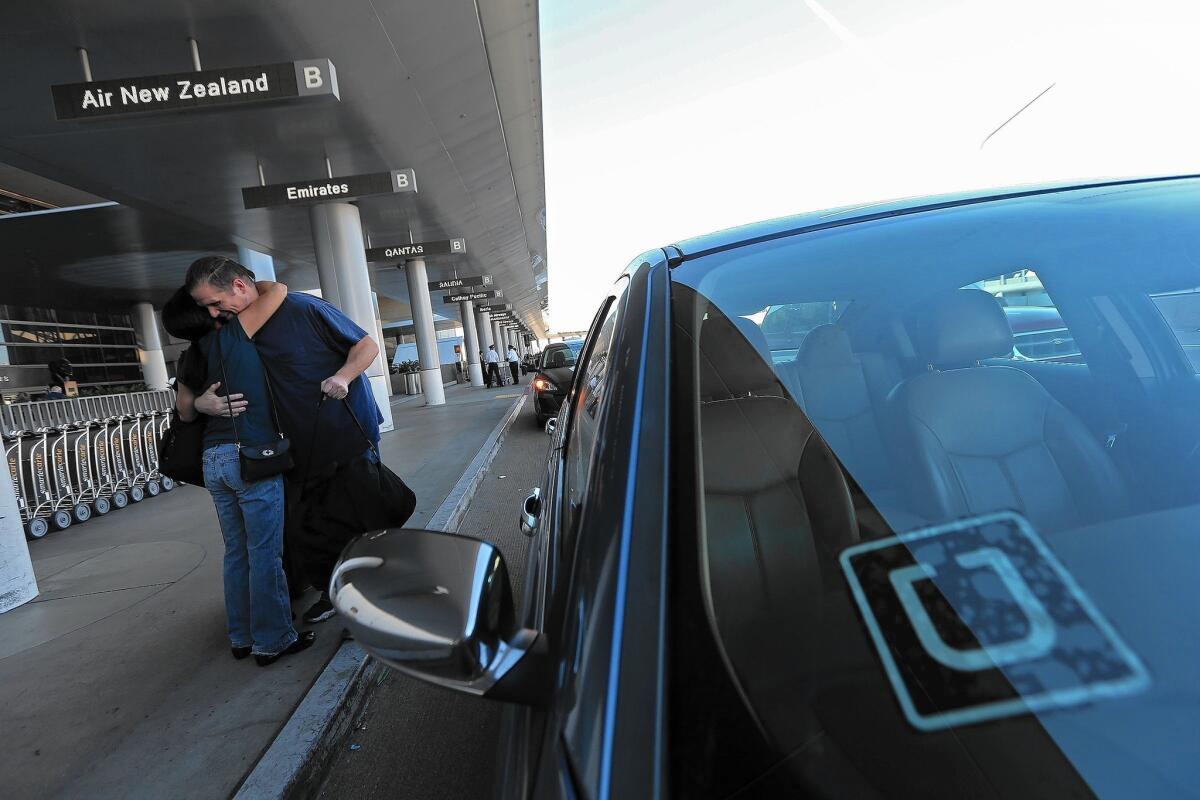Bob Hope Airport officials grappling with impact of Uber, Lyft

An Uber driver drops off a passenger as Los Angeles International Airport. At Bob Hope Airport in Burbank, officials are grappling with the impact ride-sharing services like Uber and Lyft have had on parking revenue.
- Share via
Officials at Bob Hope Airport are working to get a better handle on the activities of drivers for services such as Uber and Lyft in its parking lots as an early step in efforts to improve the parking situation at the Burbank airfield.
The on-demand transportation services are “beginning to erode [the authority’s] parking revenue,” said Dan Feger, the airport’s executive director, during a meeting of the Burbank-Glendale-Pasadena Airport Authority board Monday. Some officials have also complained that the drivers block traffic in the airport’s short-term parking structure while waiting to pick up passengers there.
The airport authority unanimously approved an interim measure that John Hatanaka, the airport’s senior deputy executive director, said is intended to manage the “explosion of these new services” and alleviate the congestion, given the limited space for pickups and drop-offs at the terminal.
Parking revenue is a significant issue for the airport, where fees make up a sizable portion of its revenue — roughly between $1.5 million and $1.8 million per month last year — and parking taxes contribute around $2 million to the city’s General Fund.
The airport recently hired a parking manager to look into ways the airport can improve its parking operations, such as through demand-based pricing and other streamlining inspired by a presentation from a Dublin Airport Authority official earlier this year.
A preliminary analysis indicated increasing numbers of passengers are choosing services like Lyft and Uber, which allow passengers to hail a ride via their smartphone, rather than driving to the airport themselves and parking there. Feger has said that the services are a fact of life for the airport that it will need to accept.
While staff continues the analysis and looks at gradual changes to make its parking options more competitive, Feger said, the interim measure will address the problem “until we can come up with a more comprehensive program.”
Officials are hopeful it will clear up some “messy activity” with the services, but they also said the new policy is less onerous or technologically challenging than those being implemented at other airports in the region and state.
Specifically, the program will be a three-year agreement that requires the companies to follow certain rules for continued permission to operate at the airfield, but also designates a specific pickup area to relieve the congestion caused by the frequent pickups.
The services will continue to be allowed to drop off customers at the terminals’ curbsides. But for pickups, the airport will shuffle some parking spaces in the short-term parking garage to create a space for Uber and Lyft drivers to load passengers without blocking the roadway. The minimum fee for using the parking structure is $3 for the first half hour, which the drivers must pay.
Drivers must also display signs on their vehicles indicating what company or service they are driving for, and if they are caught picking up passengers elsewhere on the airport, such as at the curbside, the service will be issued a notice of violation.
Three violations in 60 days will result in a six-month suspension of the service’s access to the airport, and continued violations could lead to revocation of permission to operate on the airport permanently.
“It’s not to be punitive — we don’t want to stop the services — but we want them to behave and provide [the authority] with control so that you have a fair operation here,” Hatanaka said.
Though drivers are already required to pick up passengers in the short-term parking structure, some are disobeying those rules, officials said. The added enforcement measures are expected to lead to more compliance and an increase in the number of pickups in the parking structure from around three per hour to five per hour during the hours of 7 a.m. and 10 p.m.
An Uber official said the company is looking into the planned changes.
“We are reviewing the recently-approved plan closely and look forward to working with airport officials to make ridesharing pickups and drop-offs available at Burbank-Bob Hope available for the long term, said Michael Amodeo, a spokesman for Uber.
The result is estimated to bring in an additional $2,700 in monthly parking fees collected, Hatanaka said.
--
Chad Garland, chad.garland@latimes.com
Twitter: @ChadGarland
